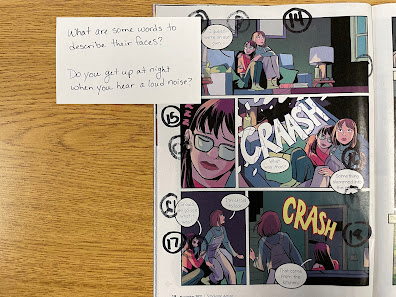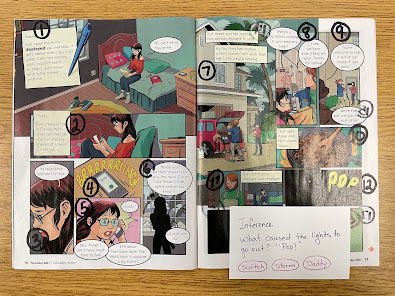
It has been a while since my last post. Distance learning ended. Summer break happened. Then the new school year started. We all know how crazy a new school year can be. Oh, and my son was born on September 2nd.
This school year, I am teaching a middle school newcomer English language class. I am also Poway Unified School District's EL TOSA for Secondary Schools. Although my posts this year will primarily focus on EL instruction, the pedagogy and methodology can be used in all classrooms and gives practical approaches to UDL.
Yesterday, my newcomers read a graphic fiction story. Before we read, we talked about the two words "graphic" and "fiction." Then, we talked about how to read an illustrated story like this. Students used Sharpie markers and number each box in sequence. This helped us read the story in the correct order. This is explicit teaching. It is so important that we don't miss these learning opportunities and simple supportive practices.
The index card on the bottom right poses a question: "What caused the lights to go out?" I wanted them to make inferences. A few students were able to say "storm" or point to the word in the story. One student needed a bit more support, so I created a multiple choice option at the bottom of the question card. The student was able to pick from three possible answers. This gave her confidence and helped her access the question in English.
It's important to remember that our newcomers can think in complex ways in their home language. We must pose challenging questions for our newcomers. Our job is to help our students share their thinking in English--and at times, in their L1.
This next picture shows how I asked my newcomers to compare and contrast two letters the main character writes to her dad. They can do this type of thinking. They struggle with finding the words in English to express their thinking. I started with the first question. I realized that they didn't have the words to express their thinking. I quickly wrote the second question: "Is she (the character) sad in the first or second letter? They were able to say, "First." They were correct. Then, I asked them to say a word or two from the letter supported their thinking. It was amazing!
As we read, I posed other questions. I wanted them to use textual details to support inferences. My students had to pick words from a list that described the faces on the two characters in cell 14. They had to point to the characters' faces to support the words they chose.
Then, we had some fun. We practiced making different faces that illustrated the words in the word bank. We had a good laugh.
The second question on the card helped them connect to the characters. I asked, "Do you get up at night when you hear a loud noise?" We did a TPS (total physical response). Hands up over your face meant, "I stay in bed and hide under my covers." Standing up meant that they had courage to investigate weird noises in the middle of the night. This was a fun way to get the students connecting with the text and the characters.
The next question was designed to build confidence and community. I asked a simple question, "What is your favorite snack in this picture?" My students enjoyed this one. What do you think they picked? Chips! Yep. They all chose chips. Then, I asked a follow up question. "What kind of chips do you like?" And now I know what to bring to class for a special treat! And the students were talking. They felt safe. They were engaged.
Finally, I wrote down the main plot points/events in the story on index cards. The cards were mixed up. The students had to read the individual sentences and work together to retell the story in sequential order. This is a supported activity because I gave them the language. They were able to reconstruct the story even though they didn't have the language to retell it themselves.
Where do you see scaffolding in this lesson? Where do you see UDL? Where do you see assets based pedagogy?
Please share your ideas, comment, or ask questions below.






Comments
Post a Comment